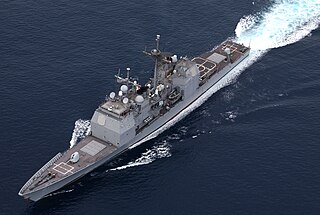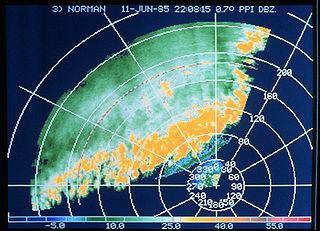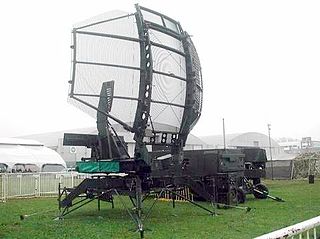
The Aegis Combat System is an American integrated naval weapons system, which uses computers and radars to track and guide weapons to destroy enemy targets. It was developed by the Missile and Surface Radar Division of RCA, and it is now produced by Lockheed Martin.

NEXRAD or Nexrad is a network of 159 high-resolution S-band Doppler weather radars operated by the National Weather Service (NWS), an agency of the National Oceanic and Atmospheric Administration (NOAA) within the United States Department of Commerce, the Federal Aviation Administration (FAA) within the Department of Transportation, and the U.S. Air Force within the Department of Defense. Its technical name is WSR-88D.

A plan position indicator (PPI) is a type of radar display that represents the radar antenna in the center of the display, with the distance from it and height above ground drawn as concentric circles. As the radar antenna rotates, a radial trace on the PPI sweeps in unison with it about the center point. It is the most common type of radar display.

The Kongō class of guided-missile destroyers in the Japan Maritime Self-Defense Force are equipped with the Aegis Combat System, and is the first of few ship classes outside the United States to have that capability. Following a decision made in December 2003, Japan is upgrading their Kongo-class destroyers with Aegis Ballistic Missile Defense System. The upgrade involves a series of installations and flight tests to take place from 2007 to 2010. JS Kongo was the first ship to have the BMD upgrade installed.
The Joint Electronics Type Designation System (JETDS), which was previously known as the Joint Army-Navy Nomenclature System (AN System. JAN) and the Joint Communications-Electronics Nomenclature System, is a method developed by the U.S. War Department during World War II for assigning an unclassified designator to electronic equipment. In 1957, the JETDS was formalized in MIL-STD-196.

The AN/TPS-43 is a transportable air search 3D radar produced in the United States originally by Westinghouse Defense and Electronic Division, which was later purchased by Northrop-Grumman. It is used primarily for early warning and tactical control, often for control over an associated surface-to-air missile battery or airfield. It is designed to be transported in two M35 cargo trucks and easily air-transportable on two pallets.
Amazon S3 or Amazon Simple Storage Service is a service offered by Amazon Web Services (AWS) that provides object storage through a web service interface. Amazon S3 uses the same scalable storage infrastructure that Amazon.com uses to run its e-commerce network. Amazon S3 can store any type of object, which allows uses like storage for Internet applications, backups, disaster recovery, data archives, data lakes for analytics, and hybrid cloud storage. AWS launched Amazon S3 in the United States on March 14, 2006, then in Europe in November 2007.
The AN/APG-80 is an Active Electronically Scanned Array (AESA) system designed and manufactured by Northrop Grumman for use on the Lockheed Martin F-16 Fighting Falcon fighter aircraft. It was originally designed to be included on the F-16C/D Block 60 Desert Falcon aircraft ordered by the United Arab Emirates, subsequently reclassified as the F-16E/F Block 60 Desert Falcons; first deliveries were made in 2003.

Surface movement radar (SMR) is used to detect aircraft and vehicles on the surface of an airport. It is used by air traffic controllers to supplement visual observations. It may also be used at night time and during low visibility to monitor the movement of aircraft and vehicles. Surface movement radar is the term accepted by ICAO, but it has historically been known by other names such as ground movement radar, airport surface detection equipment (ASDE) and airfield surface movement indicator.

AN/TPQ-53 Quick Reaction Capability Radar is a mobile active electronically scanned array counter-battery radar system manufactured by Lockheed Martin. The radar is specifically designed to locate the firing positions of both rocket and mortar launchers.
Radar envelope is a critical Measure of Performance (MOP) identified in the Test and Evaluation Master Plan (TEMP). This is the volume of space where a radar system is required to reliably detect an object with a specific size and speed. This is one of the requirements that must be evaluated as part of the acceptance testing process.

Side-looking airborne radar (SLAR) is an aircraft- or satellite-mounted imaging radar pointing perpendicular to the direction of flight. A squinted (nonperpendicular) mode is also possible. SLAR can be fitted with a standard antenna or an antenna using synthetic aperture.

A primary radar or primary surveillance radar (PSR) is a conventional radar sensor that illuminates a large portion of space with an electromagnetic wave and receives back the reflected waves from targets within that space. The term thus refers to a radar system used to detect and localize potentially non-cooperative targets. It is specific to the field of air traffic control where it is opposed to the secondary radar which receives additional information from the target's transponder.
Airport surveillance and broadcast systems are a set of runway-safety tools that display aircraft on and near an airport.

AN/SPS-6 is a two-dimensional radar manufactured by Bendix and Westinghouse Electric. It was used by the US Navy as a first-generation air-search radar after World War II, and was widely exported to allies. In addition, the improved AN/SPS-12 is the derivative types developed in other countries.

AN/SPS-10 is a two-dimensional radar manufactured by Raytheon Technologies. It was used by the US Navy as a surface-search radar after World War II and was equipped aboard naval ships during the Cold War. Variants include AN/SPS-10B, AN-SPS/10E, and AN/SPS-10F.

AN/SPS-8 is a two-dimensional radar manufactured by General Electric. It was used by the US Navy as a height finding radar after World War II, and was equipped aboard naval ships during the Cold War. Variants include AN/SPS-8A, AN-SPS/8B, AN/SPS-8C and AN/SPS-8D After modernization, it was redesignated as AN/SPS-30.

The Ground Master 200 (GM200) is a medium range AESA 3D radar manufactured by Thales Group.













